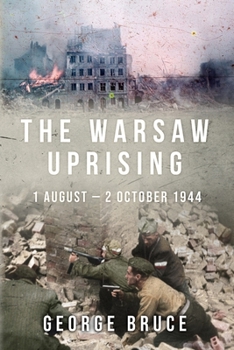The Warsaw Uprising: 1 August - 2 October 1944
Select Format
Select Condition 
Book Overview
An engrossing history of the largest resistance movement in the Second World War. Ideal for readers of Anthony Beevor, Max Hastings and Alex Kershaw. By the summer of 1944 Poland had been occupied by Nazi forces for nearly five years, but on August 1 the people of Warsaw attempted to throw off their shackles and rise up against their Nazi oppressors. For sixty-three days German tanks, planes and artillery crushed the ill-equipped...
Format:Paperback
Language:English
ISBN:1800550456
ISBN13:9781800550452
Release Date:February 2021
Publisher:Sapere Books
Length:338 Pages
Weight:1.15 lbs.
Dimensions:0.8" x 6.0" x 9.0"
Related Subjects
HistoryCustomer Reviews
1 rating
A Concise, Detailed Account of the Warsaw Uprising
Published by Thriftbooks.com User , 17 years ago
This book provides a great deal of information squeezed into a relatively small book. Its only obvious shortcoming is the credence it gives to Communists such as Zenon Kliszko. Modern Holocaust materials are typically so Judeocentric that one gets the impression that Poles lived quasi-normal lives under the German occupation. Bruce knows better: "The Gestapo were constantly active. Everyone feared finding his name in black print in their lists of wanted men. In streets, cafes, shops, all Poles, even adolescents, had to keep alert and watch what went on, for at any moment they could be seized in a street-raid, flung into a lorry and never seen again." (p. 28). "...they never knew whether they would ever come home again if they ventured on to the streets, or whether they would be seized in one of the massive house-to-house searches were they to stay at home." (p. 68). In October 1943, Bor-Komorowski gave an order for the Underground to combat brigandry, which was a very real problem in the Polish countryside. Funny how this became a Rorschach test for Polonophobic sentiments! Stalin got wind of the order and asserted that it was a veiled order to combat Communist guerillas (p. 52). More recently, certain Jewish authors have imagined that it was a veiled order to kill fugitive Jews. The Warsaw Uprising was an unprecedented event: "Never before in history had insurgents tried to take over so big a town or city; nor had the difference in military power between the two sides ever been so marked." (p. 114) Bruce devotes considerable detail to the combat during the Uprising. He comments: "Persistent as volcanic lava the Poles seeped back again into positions they had lost as need called the Nazis away to other points in the city." (p. 137). "The Germans ascribed this Polish resilience to well-thought-out tactics which permitted German assault troops, flame-throwers, and even tanks to advanced right up to the barricades and then broke up these attacks by Piat mortars, incendiary bottles, machine-gun fire and sniping at officers...The Poles believed that they would either be tortured to obtain information, or shot out of hand, according to which unit captured them, so never surrendering, they fought to the end." (p. 145). A captured German diary reflected the fear and despair which the Germans felt when encircled by Poles (p. 160). Although Sosnkowski saw both Soviets and Nazis as Poland's enemies, and was opposed to the launching of the Uprising, he had what turned out to be a prescient view of its significance: "Acts of despair are sometimes unavoidable in the lives of nations, owing to the feelings of the nation, the political symbolism of such acts and their moral significance for posterity." (p. 50).






